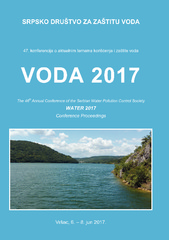Приказ основних података о документу
Ocena ekološkog statusa/potencijala vodnih tela u Republici Srbiji – stanje i razvoj
| dc.contributor | Đukić, Aleksandar | |
| dc.creator | Raković, Maja | |
| dc.date.accessioned | 2022-07-06T11:26:20Z | |
| dc.date.available | 2022-07-06T11:26:20Z | |
| dc.date.issued | 2017 | |
| dc.identifier.isbn | 978-86-916753-4-9 | |
| dc.identifier.uri | http://radar.ibiss.bg.ac.rs/handle/123456789/5017 | |
| dc.description.abstract | The implementation of the Water Framework Directive (WFD 2000) in the Republic of Serbia started in 2003. Since that time, considerable data is collected. One of the main tasks that have been fulfilled in respect to the WFD implementation was development of the system of the assessment of the water bodies’ status, including the ecological status evaluation (RS 2011). The aim of this work is to critically discuss the state of the art of the assessment system in the country and to provide the plan for further system development. Also, the comparison of Serbian system with other assessment schemes in “Danubian” countries is provided. The ecological status assessment system in Serbia is type specific (six type groups of running waters, two general lake types and artificial water bodies) and covers supporting parameters and obligatory biological quality elements, except fish fauna. The system of assessment of ecological status involves the parameters that are commonly used in the countries in the Danube Basin - for macroinvertebrates: Saprobic index, BMWP and ASPT score, total No. of taxa BNBI index, as well as share of selected taxa or ecological groups (EPT, share of Oligochaeta: Tubificidae, No. of Bivalvia and Gastropoda species and No. of sensitive taxa); for phytoplankton abundance, biomass (Chl a) and share of Cyanobacteria and Euglenophyta; for phytobenthos IPS and CEE indexes; and for aquatic macrophytes: total No. of taxa and Shannon Diversity Index. The three step system of assessment of confidence level is also incorporated in the assessment procedure. Since in Serbian waters organic and microbial pollution from untreated urban wastewaters and live stocking waste is one of the major pollution sources, microbiological parameters are also part of the assessment system. First step in further development of the szstem of ecological status assessment is involvement of fish fauna. Further, based on the results of testing of the present version of the assessment system, it could be concluded that the scheme is effective for general degradation of water bodies and that the border between good and moderate status is well identified. There is a need for development of stressor specific assessment system. Further, there is necessity for providing single value for ecological status (Ecological Status Ratio) ranging from 0 to 1. | sr |
| dc.language.iso | sr | sr |
| dc.publisher | Belgarde: Serbian Association for Water Protection | sr |
| dc.rights | openAccess | sr |
| dc.source | Conference proceedings: 46th Annual Conference of the Serbian Water Pollution Control Society: Water; 2017 June 6-8; Vršac, Serbia. | sr |
| dc.subject | Water Framework Directive | sr |
| dc.subject | Ecological status assessment | sr |
| dc.subject | biological parameters | sr |
| dc.title | Ocena ekološkog statusa/potencijala vodnih tela u Republici Srbiji – stanje i razvoj | sr |
| dc.type | conferenceObject | sr |
| dc.rights.license | ARR | sr |
| dc.rights.holder | © 2017 by the Serbian association for water protection | sr |
| dc.description.other | Đukić A, editor. Conference Proceedings: 46th Annual Conference of the Serbian Water Pollution Control Society: Water 2017; 2017 Jun 6-8; Vršac, Serbia. Belgarde: Serbian Association for Water Protection; 2017. p. 39. | sr |
| dc.citation.spage | 39 | |
| dc.type.version | publishedVersion | sr |
| dc.identifier.cobiss | 235361548 | |
| dc.identifier.fulltext | https://radar.ibiss.bg.ac.rs/bitstream/id/10745/VODA-2017-39.pdf | |
| dc.citation.rank | M64 | |
| dc.identifier.rcub | https://hdl.handle.net/21.15107/rcub_ibiss_5017 |

